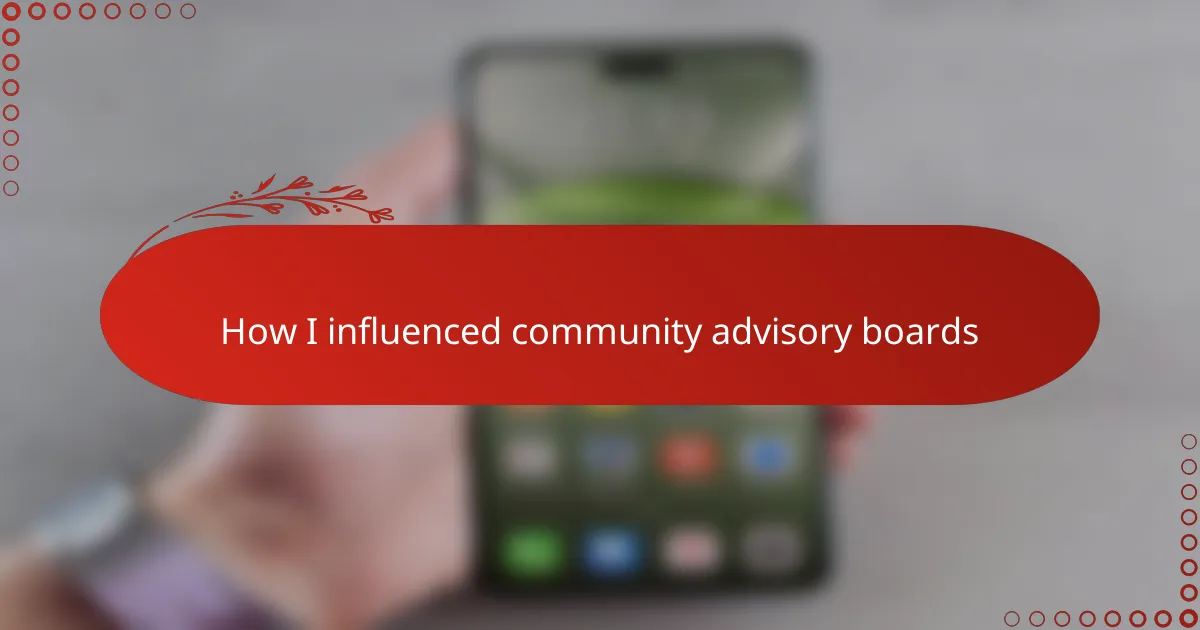Key takeaways
- Community advisory boards bridge the gap between radio stations and their audience, fostering participation and empowering listeners to share their voices.
- Active engagement of advisory boards leads to authentic programming that reflects local interests, creating a dynamic relationship between stations and communities.
- Regular communication and creating a welcoming environment for feedback are essential for keeping advisory board members motivated and invested.
- Successful collaborations between boards and stations can transform content, increase listener engagement, and strengthen community ties.

What are community advisory boards
Community advisory boards are groups of local listeners who provide feedback and guidance to radio stations. They serve as a bridge between the station and its audience, ensuring programs reflect the diverse interests and needs of the community. Have you ever wondered how radio shows decide what topics to cover or music to play? This is where these boards play a crucial role.
From my experience, these boards not only help stations stay tuned to the pulse of their listeners but also foster a sense of belonging and participation. I’ve seen how being part of such a group empowers individuals to voice concerns and ideas that might otherwise go unheard. It’s more than just advice; it’s a meaningful conversation that shapes the station’s identity.
What strikes me most is the passion board members bring to the table. They care deeply about their community, and their input transforms programming from a one-way broadcast into a shared experience. Without their involvement, radio stations risk losing touch with the very people they aim to serve.
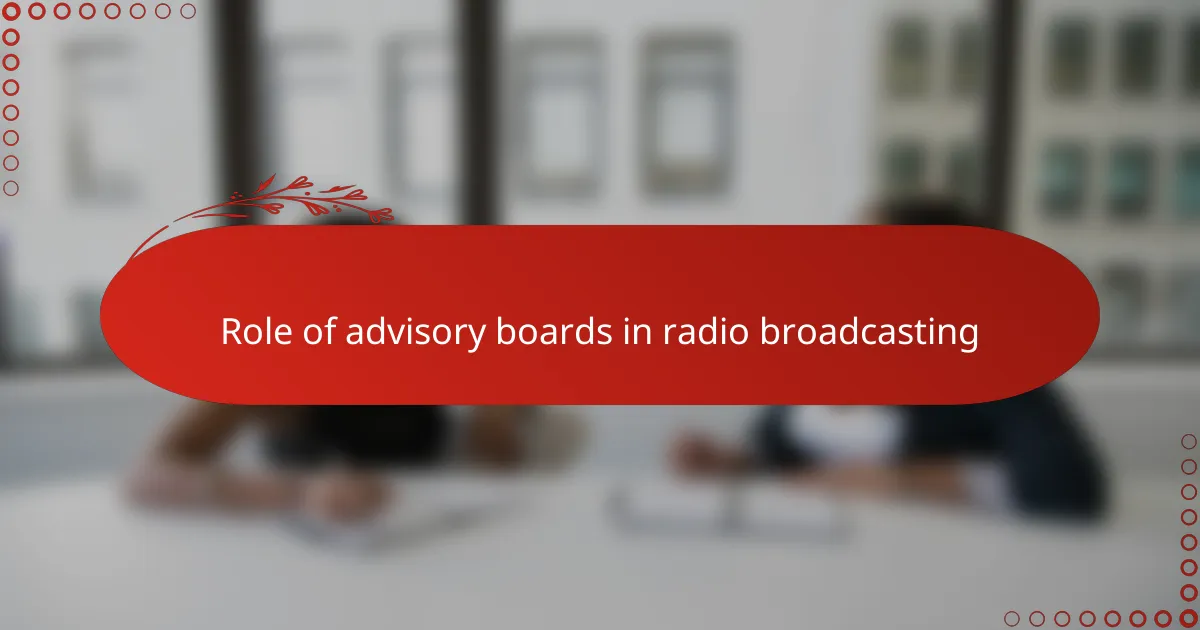
Role of advisory boards in radio broadcasting
Advisory boards act as the station’s compass, helping broadcasters navigate the ever-changing tastes and concerns of their local audience. I’ve noticed that when a board is actively engaged, the content feels more authentic and relevant—it’s like tuning into a conversation with neighbors rather than a distant voice.
Have you ever listened to a show and felt it truly understood your community? That’s rarely a coincidence. These boards offer critical insights that shape programming decisions, from choosing music genres to spotlighting local issues. Their role isn’t just advisory; it’s foundational in creating that connection.
In my experience, the most powerful impact of advisory boards is how they democratize radio. They give real people a seat at the table, turning passive listeners into active contributors. This shared ownership fuels a stronger bond between the station and its audience, something I’ve seen bring entire neighborhoods closer through the airwaves.

Benefits of community feedback for stations
One of the biggest benefits I’ve seen from community feedback is how it sharpens a station’s focus. When listeners share their thoughts, stations can fine-tune their programming to better meet real interests instead of guessing what might work. Have you ever noticed how some shows just seem to “get” your vibe? That’s no accident—it’s the power of genuine feedback.
From my perspective, this kind of input breathes life into the station. It moves beyond stale, one-way communication and creates a dynamic relationship where content evolves naturally. I recall a station that shifted its weekend lineup based on suggestions from their advisory board, and the change instantly sparked more listener engagement and loyalty.
Sometimes, it’s the simple things that matter most. Community feedback helps stations identify gaps or issues that insiders might overlook, like underrepresented voices or local concerns. When a station listens closely, it becomes a true community hub, reflecting the heart and soul of its audience. Isn’t that what good radio should be all about?
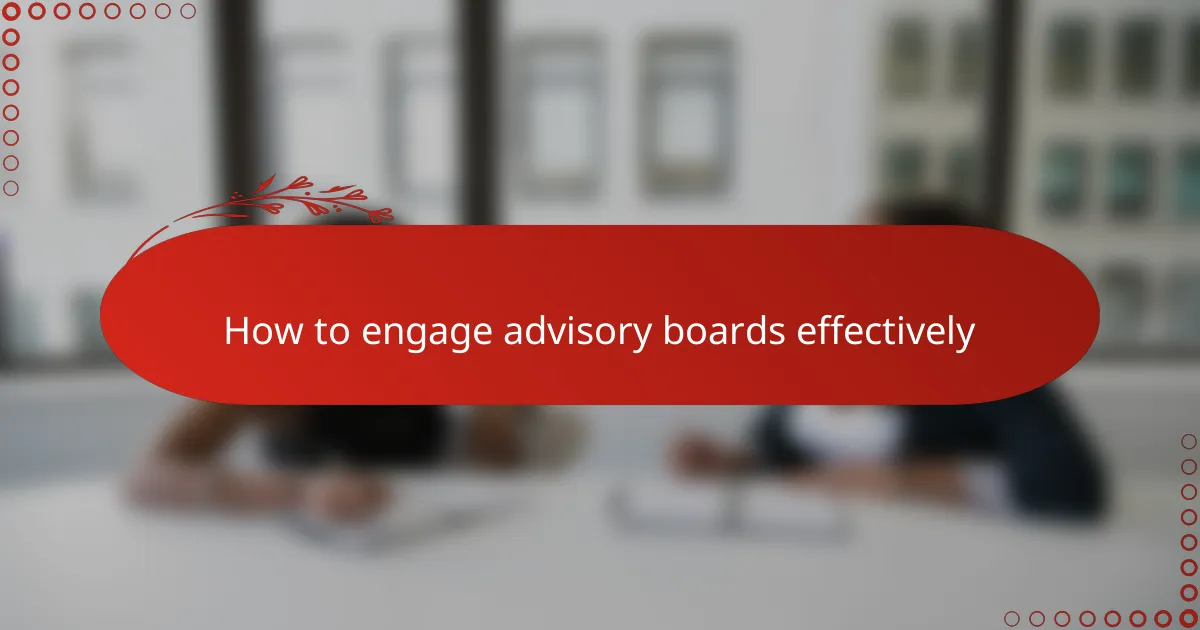
How to engage advisory boards effectively
Keeping advisory board members actively involved means making their input feel valued and impactful. I’ve learned that regular updates on how their suggestions have influenced programming really motivate continued participation. Have you ever been part of a group where your ideas seemed to disappear? Avoiding that feeling is key to long-term engagement.
I also find that creating a welcoming and open environment encourages honest feedback. When I chaired meetings, I made sure everyone had a chance to speak and that differing opinions were respected. It’s amazing how that simple practice helped board members feel heard and invested in the station’s success.
Finally, mixing formal meetings with informal interactions can deepen relationships. I’ve seen how casual conversations outside the boardroom often lead to the most genuine ideas and stronger community ties. Don’t underestimate the power of a friendly chat in keeping an advisory board connected and inspired.
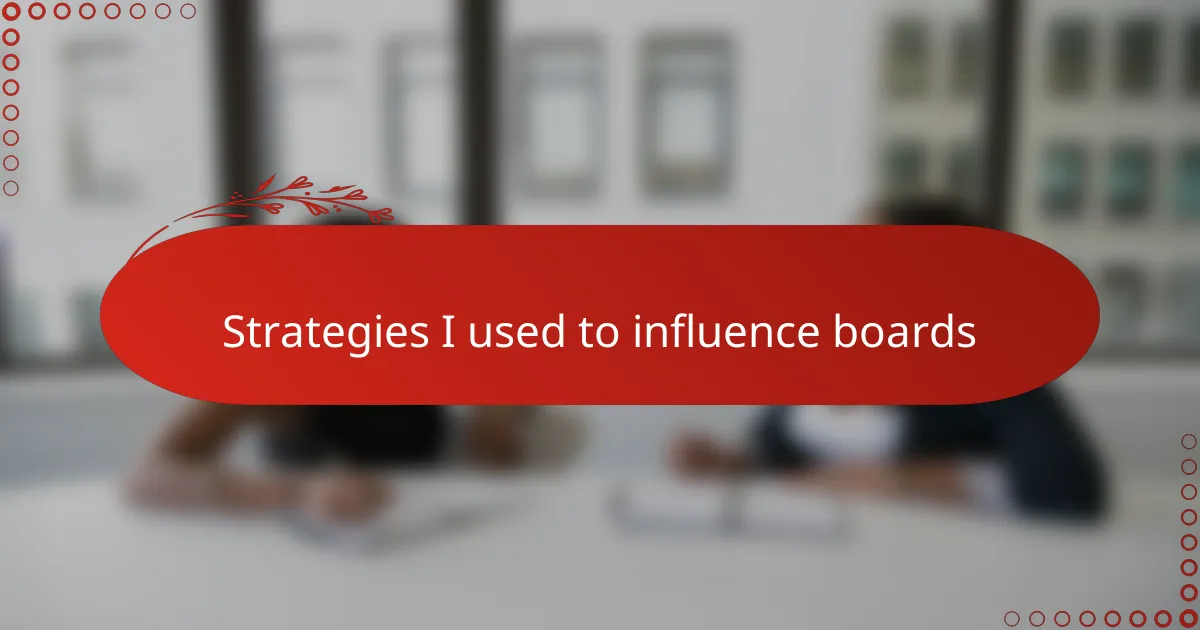
Strategies I used to influence boards
One strategy I relied on was building genuine relationships with board members. I found that when people feel personally connected, their willingness to contribute and embrace new ideas grows naturally. Have you ever noticed how a simple conversation over coffee can open doors that formal meetings struggle to unlock? That was often the case in my experience.
Another approach that proved effective was framing my suggestions in ways that aligned with the board’s passion for community impact. By showing how certain changes could amplify their influence or better serve listeners, I tapped into their sense of purpose. It’s amazing how much more receptive people become when they see the bigger picture and their role within it.
I also made a point to listen actively and adapt my ideas based on the board’s feedback. This back-and-forth not only built trust but made the final decisions feel truly collaborative. After all, who wouldn’t want to be part of a process where their voice shapes the outcome? That feeling of ownership was key to moving ideas forward.
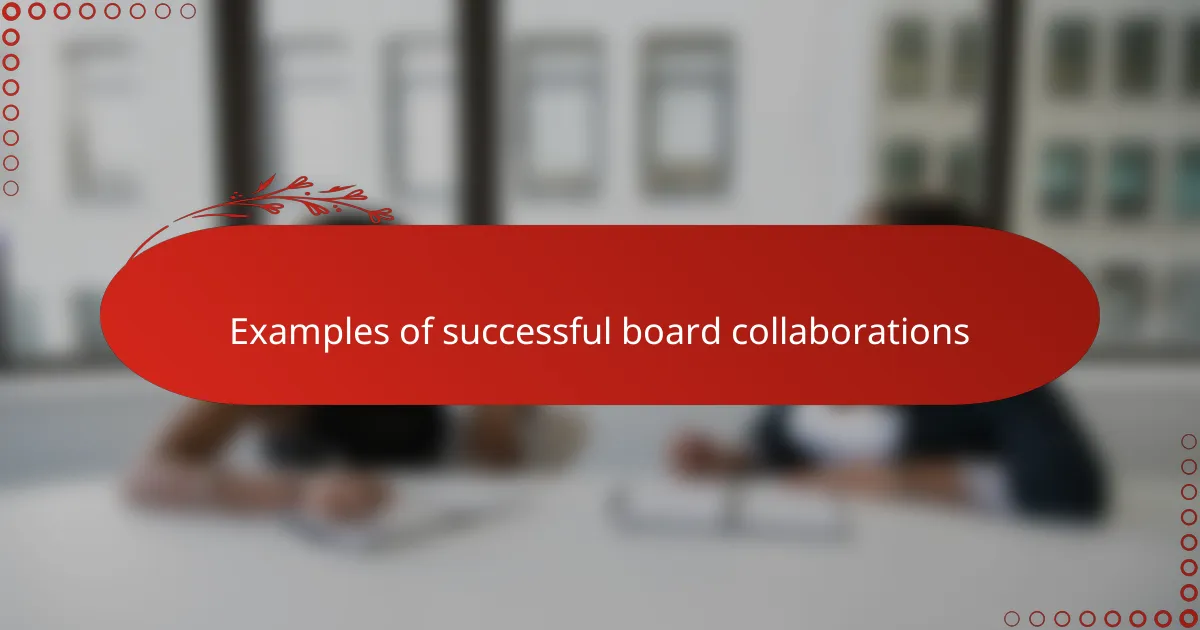
Examples of successful board collaborations
One memorable example I often think about is when our advisory board collaborated on redesigning the station’s local news segment. By incorporating their feedback, we shifted from a generic rundown to a more community-centered approach—featuring neighborhood stories and listener interviews. The result? Listener engagement soared, and the board’s enthusiasm visibly grew, knowing their voices truly shaped the content.
I recall another time when the board united to launch a special cultural series that spotlighted underrepresented groups in our city. Their collective vision turned what could have been a small project into a celebrated monthly event that listeners eagerly anticipated. Doesn’t it feel rewarding when a group effort creates something that resonates so deeply with the community?
What stood out most was how the advisory board didn’t just suggest ideas; they became active partners in execution. Whether helping with event promotion or gathering local artists for live sessions, their involvement went beyond advice. That hands-on collaboration turned a simple broadcast into a vibrant community celebration, proving the immense value of working together closely.
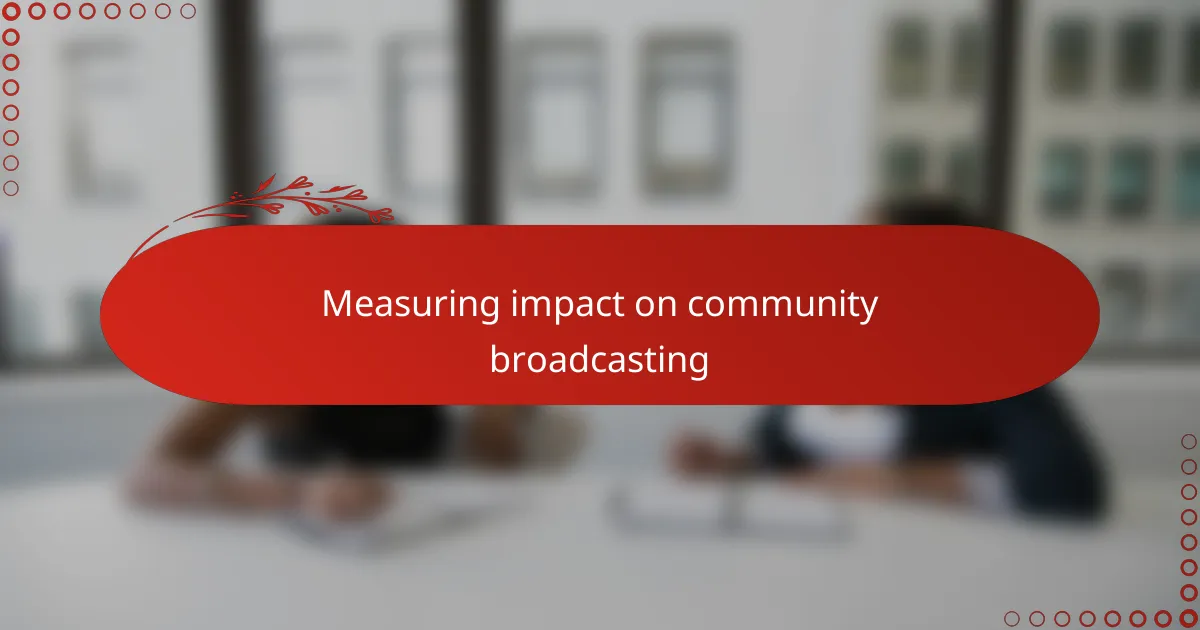
Measuring impact on community broadcasting
Measuring the impact on community broadcasting isn’t always straightforward. I’ve often relied on a mix of listener feedback, engagement metrics, and direct input from advisory boards to get a real sense of how well the station is connecting. Have you ever wondered if the changes you make actually resonate with the audience? That’s where these measures become invaluable.
In my experience, qualitative insights—like heartfelt listener stories or enthusiastic board member testimonials—can be just as telling as numbers. One time, after implementing board suggestions, I noticed a surge in calls and social media comments praising the station’s new focus on local issues. Those moments made the impact feel tangible and deeply rewarding.
Of course, it’s also essential to track harder data like listener numbers or participation rates at events. But beyond stats, I find the true measure lies in the strengthened trust and sense of community that grows when listeners feel genuinely heard and represented. Isn’t that the ultimate goal for any community broadcaster?
